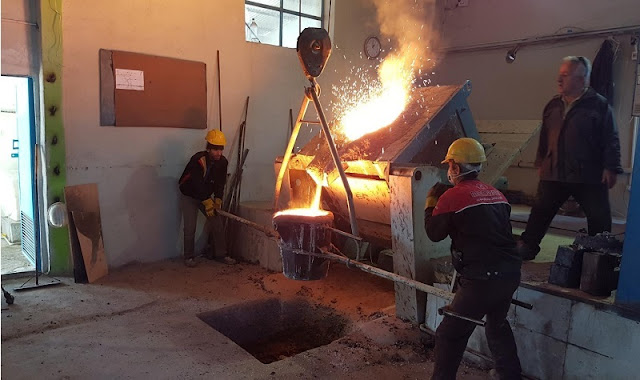How to Operate an Induction Furnace?
Furnace Inspection
1. Check for cold cracks in the furnace body. Cracks below 2 mm are not used for repair. Cracks exceeding two milli-meters must be repaired.
2. Pay special attention to horizontal cracks because horizontal cracks are difficult to bridge when starting the furnace. 1.3 Frequently check the melting loss of the furnace body, and the inspection method must be accurate.
Cold Furnace Open
Heating curve; 200-300 degrees per hour in the beginning; when the temperature reaches 900-1000 degrees; work according to the normal operating process.
Hot Furnace Shutdown
After pouring the molten iron, clean up the slag, put in the molten iron block, heat it until the molten block is red, cover the furnace cover, and let the furnace body cool down slowly. Remember not to use compressed air to cool the furnace body rapidly.
Operation Matters
1. Pay attention to prevent mechanical damage to the furnace mouth when adding the charge.
2. The slag in the furnace should be cleaned as much as possible, because the slag is particularly eroded to the furnace body, and there are many harmful chemical components in the slag, which can easily cause abnormal melting loss locally.
3. When adding the molten iron after desulfurization, the slag must be removed. Prevent the alkaline chemicals in the molten iron from entering the intermediate frequency furnace through the molten iron transfer package.
Once it enters the furnace body, it will chemically react with the refractory material in the furnace body, and the furnace body refractory material will produce abnormal melting and erosion.
4. When the use temperature does not reach the use temperature of the selected refractory material, the temperature of the molten iron in the furnace should be increased 1-2 times a week to the use temperature of the refractory material.
5. When the alloy is added, its solid size is not more than 30 mm to prevent the alloy from sinking to the bottom and dissolving and damaging the refractory at the bottom of the furnace body after it reacts with the molten iron.
6. Pay attention to iron oxide in molten iron daily.
If necessary, add metallurgical grade carbonized ferrosilicon to reduce iron trioxide in the molten iron. However, the temperature of adding ferrosilicon should be controlled at 1350-1400 degrees for 15-25 minutes, which is beneficial The ferrosilicon melts. 4.7 When pouring molten iron, the power supply of the furnace body must be turned off to prevent the molten iron at the bottom of the furnace from overheating.
Please contact stella@hanrm.com for a quotation.
And free send inquiry to us.
Email: stella@hanrm.com stellarollingmill@gmail.com
Whatsapp/Wechat:+8615877652925
More News You May Interesting:
Industrial Frequency Induction Furnace
Melting Features of Medium Frequency Electric Furnace
Electric Arc Furnace VS Intermediate Frequency Furnace
Cause Analysis and Solution of Induction Coil Blocking in Medium Frequency Smelting Furnace
Why Intermediate Frequency Furnace cannot be Turned on Normally?
Energy Efficiency Control System of Submerged Arc Furnace
Furnace Transformer – Electric Arc Furnace
What is Induction Furnace?
How does a Blast Furnace Work?
Significance of Reheating Furnace Technology in Rolling Reheating Furnace
Why Use Coke for Blast Furnace Ironmaking does not Use Coal Directly?
How to Improve the Thermal Efficiency of the Reheating Furnaces?
What is the Reheating Furnace Temperature System?
Advantages of Walking Beam Reheating Furnace
Walking Beam Reheating Furnace
The Development Trends and Advantages of Electric Arc Furnaces
The Advantage of Induction Furnace ( Medium Frequency Furnace)



评论
发表评论